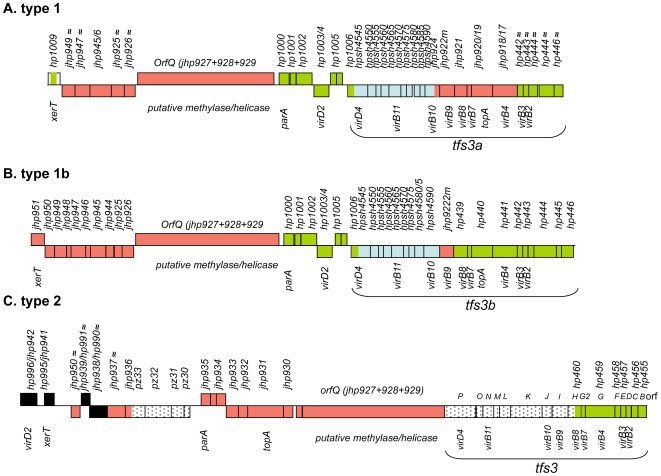Figure 1. Three types of TnPZs.
Coding: boxes in green, orfs with homologies to genes in reference strain 26695 (orf numbers start with hp); in red, orfs with homologies to reference strain J99 (orf numbers start with jhp); in black, orfs common to strains 26695 and J99; boxes in blue (hpsh_04545 - hpsh_04590), first found in Shimaa strain Shi470 and then in other type 1 and type 1b TnPZs (Figs. S1, S2, S6); boxes with dots, orfs first found in strain PeCan18B and then in all full size type 2 TnPZs (tfs3 orfs H-P, and orfs pz30-pz33); Orfs marked with ≈, relatively low protein-level identities to their homologs in reference strains 26695 and J99 (range of 35–70%); other orfs that are not marked with ≈ have protein identities of 90–95% to those in these reference strains. Orfs transcribed rightward are represented above the main line, and those transcribed leftward are shown below the line. Note that adjacent orfs in Shi470 were numbered in fives (hpsh_04545, hpsh_04550, hpsh_04555, etc.) by the NCBI genome annotation pipeline team. Designations B through Q correspond to orf names used in our initial description of the tfs3 type IV secretion gene cluster [24]. A. Type 1 TnPZ. This type was found in the strain Shi470 genome sequence (GenBank Accession CP001072, hpsh_04480-hpsh_04640), in 35 of the other 44 Shimaa village strains (by PCR), and also in the strain G27 genome sequence ([34], GenBank Accession CP001173, HPG27_986 - HPG27_959). These TnPZs have type 1 specific xerT genes (full length versions of strain 26695's truncated hp1009 gene) on the left, a tfs3a element on the right, and a centrally located type 1-specific virD2 allele. Although most genes are closely related to genes found in reference strains 26695 and J99, some of them (jhp0949, jhp0947, jhp0925-6 near the left end and hp0442 – hp0446 near the right end, marked with ≈) are divergent allelic forms, specific for type 1 TnPZ elements. B. Type 1b TnPZ, as in strain P12 (GenBank Accession CP001217, orfs HPP12_437 - HPP12_473), is likely to be a hybrid element, consisting of a type 1 TnPZ central region (orfQ through virB9) that contains ∼8 kb segments at each end from another distinct TnPZ element, unrelated at the DNA sequence level, although similar in gene content and arrangement, to type 1 TnPZs. Type 1b-specific sequences are present in 26695 and J99 plasticity zones. C. Type 2 TnPZ, found in H. pylori strains PeCan18B (GenBank Accession AF487344), Shi170 (GenBank Accession EU807988) and P12 (GenBank Accession CP001217, orfs HPP12_01320- HPP12_01353), and also in a strain of H. cetorum (GenBank Accession EU015081). Type 2 TnPZs start with type 2 specific virD2 and xerT genes on the left and end with the tfs3 gene cluster on the right. The region between jhp0939/hp0991 and xerCD (2.4 kb) is variable among type 2 strains.

